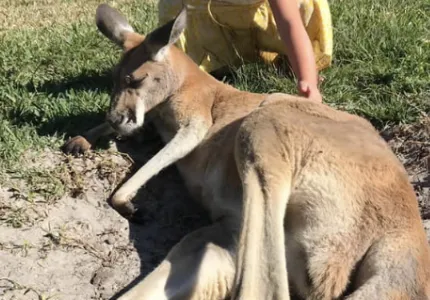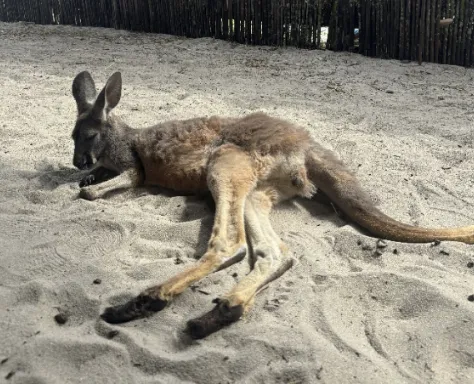

Red Kangaroo
by: Darian Borghei
Guess which animal is the largest member of the marsupial family, often recognized for its distinctive hopping gait and pouch for carrying its young.
If you guessed the Red Kangaroo, you are right!
Overview: Red Kangaroos (Macropus spp.) are iconic marsupials native to Australia, known for their unique adaptations to the arid and semi-arid regions of the continent. They are closely related to other marsupials such as wallabies, wallaroos, and quokkas, all belonging to the Macropodidae family. Kangaroos are primarily found across Australia, inhabiting diverse habitats ranging from grasslands and woodlands to scrublands and coastal areas.
Physical Description: Kangaroos vary in size depending on the species, with the largest species, the red kangaroo, standing up to 6 feet tall and weighing around 200 pounds. Other species, such as the smaller wallabies, are much smaller, standing around 2 feet tall. Kangaroos have powerful hind legs built for hopping, a long muscular tail for balance, and distinctive large ears. Their fur can range in color from reddish-brown to gray.
Diet and Eating Habits: Kangaroos are herbivores, primarily feeding on grasses, shrubs, and leaves. They are adapted to grazing in open habitats, using
their specialized teeth to efficiently grind down tough plant material.
Behavior and Personality: Kangaroos are known for their social behavior and are often found in groups called mobs. They communicate through vocalizations, gestures, and body language, establishing dominance hierarchies within the group. Despite their reputation for aggression, kangaroos are generally peaceful animals, preferring to flee from threats rather than confront them.
Domestication and Uses: Kangaroos have not been domesticated to the same extent as some other animals, but they hold cultural significance for indigenous Australian communities, featuring prominently in Aboriginal folklore and art. In modern times, kangaroos are sometimes hunted for their meat and skins, though strict regulations govern kangaroo harvesting in Australia.
Cultural Significance: Kangaroos hold cultural significance for indigenous Australian communities, where they are revered for their role in traditional
stories, ceremonies, and as a source of food and materials. In Australian culture, kangaroos are symbols of the country's unique wildlife and are featured on the Australian coat of arms.
Economic Importance: Kangaroo harvesting contributes to the Australian economy through the sale of kangaroo meat and leather products. However,
controversies surround kangaroo harvesting due to ethical and conservation concerns.
Conservation Status: Kangaroos are not considered endangered, with stable populations across Australia. However, certain species, such as the Tasmanian pademelon, face threats from habitat loss and predation by introduced species.
Takeaway: Kangaroos play a vital role in Australia's ecosystems and cultural heritage. By supporting conservation efforts and sustainable management practices, we can ensure the continued survival of these iconic marsupials for future generations to appreciate. Help keep our kangaroos safe and around us longer by donating to The Kangaroo Sanctuary.
